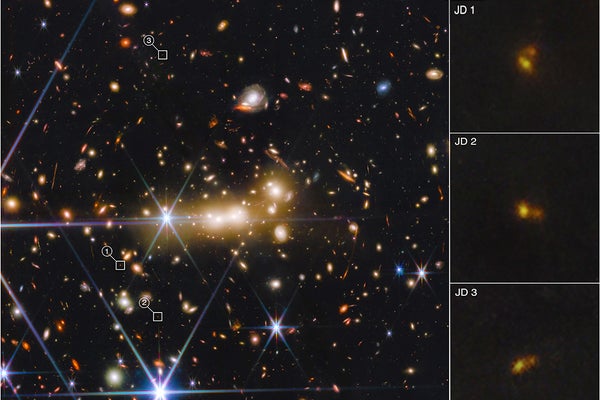A cosmic collision that may be the oldest galaxy merger ever seen has appeared in images from the James Webb Space Telescope (JWST). The photographs reveal ancient galaxies close to crashing into each other during the first 500 million years after the birth of the universe. This merger appears to beat the former record holder by a full 300 million years. The observation is described in two papers—one published in the Astrophysical Journal Letters in early June and another currently under peer review—both led by Tiger Yu-Yang Hsiao, a graduate student at Johns Hopkins University.
Dan Coe, principal investigator of the project, first spotted the merging galaxy, MACS0647-JD, with the Hubble Space Telescope about a decade ago. At the time, it looked like little more than a red speck. It appeared in Hubble’s image three times because of distortion and magnification from a massive cluster of galaxies sitting between it and Earth—an effect called gravitational lensing. Based on its redshift—a measure of how much its light has been stretched into the red end of the spectrum from the expansion of the universe—MACS0647-JD seemed to be the oldest galaxy then known, though even older galaxies have been observed in the years since. Nevertheless, once JWST was operational, Coe, an astronomer at the Space Telescope Science Institute in Baltimore, Md., knew he had to take another look and tasked Hsiao with analyzing the new observatory’s data.
Despite its unappetizing name, MACS0647-JD has given astronomers a taste for the diversity of galaxies that formed within the first 500 million years of the universe. Its surprising shape looks like a lopsided peanut, and it has two clumps of stars on opposite ends, indicating that it is most likely two galaxies that formed separately before beginning to blend into one. The two clumps—unpoetically named “A” and “B”—have different colors, amounts of dust and rates of star formation. The A clump is bluer, mostly free of dust and bursting with baby stars, whereas B is redder, dustier and comparatively lacking in new stars. Furthering the case for the merger claim, the A component is estimated to be tens of millions of years younger than its companion.
On supporting science journalism
If you're enjoying this article, consider supporting our award-winning journalism by subscribing. By purchasing a subscription you are helping to ensure the future of impactful stories about the discoveries and ideas shaping our world today.
There is nonetheless a small chance that the object is an unstable galaxy that formed two clusters of stars at different times. “If you see a galaxy that’s very asymmetric, that’s usually an indication of a recent merger,” says Vicente Rodriguez-Gomez, an associate professor at the National Autonomous University of Mexico, who was not involved with the new papers. “However, that’s not always the case. You can also have a galaxy that is asymmetric for other reasons.” One of those reasons is a clumpy history of star formation that occurs naturally in some galaxies. Even in our own Milky Way, there are stellar clusters with densities of stars and dust above the galactic average.
Both Rodriguez-Gomez and Francisco Muller-Sanchez, an assistant professor and observational astronomer at the University of Memphis, who was not involved with the research, feel that the team’s methodology, results and analysis are compelling, however.
To know for sure that the two parts of MACS0647-JD are approaching collision, astronomers could observe the object in longer, redder wavelengths to measure its molecular gas, Muller-Sanchez notes. “When you have a merger, you usually have tidal tails—tails of gas that connect one galaxy to another,” he says. “By looking at the molecular gas, you will get an extra confirmation, and it will be a very strong confirmation.”
The ideal instrument for this kind of observation would be the Atacama Large Millimeter Array (ALMA) in Chile, the world’s largest astronomical facility. But that’s not an option: ALMA observes the Southern Hemisphere, and MACS0647-JD is nestled between Ursa Major and Ursa Minor in the north.
Whether or not MACS0647-JD is on the verge of a merger, it is destined for another one. A third component of stars and gas, separated from the main object by roughly 3,000 parsecs (9,800 light-years), looks to be bound to it by gravity and will eventually fall in.
Finding an apparent triple merger such as this is exciting but not unexpected. Based on most models, astronomers expect to discover an ever greater fraction of galaxies crashing into each other the earlier into the universe we peer, at least out to about 270 million years after the big bang. Coe mentions that the JWST Advanced Deep Extragalactic Survey, which covers more area in greater detail than the Hubble Ultra Deep Field, has already spotted a plethora of distant galaxies that Hubble missed, all in the same cosmic epoch as MACS0647-JD. Many of them, on closer inspection, could be revealed to be galaxy mergers as old as, or older than, MACS0647-JD. Already JWST’s observations of the earliest galaxies have started to paint new details into the picture of how our universe evolved and came to be what it is today.
